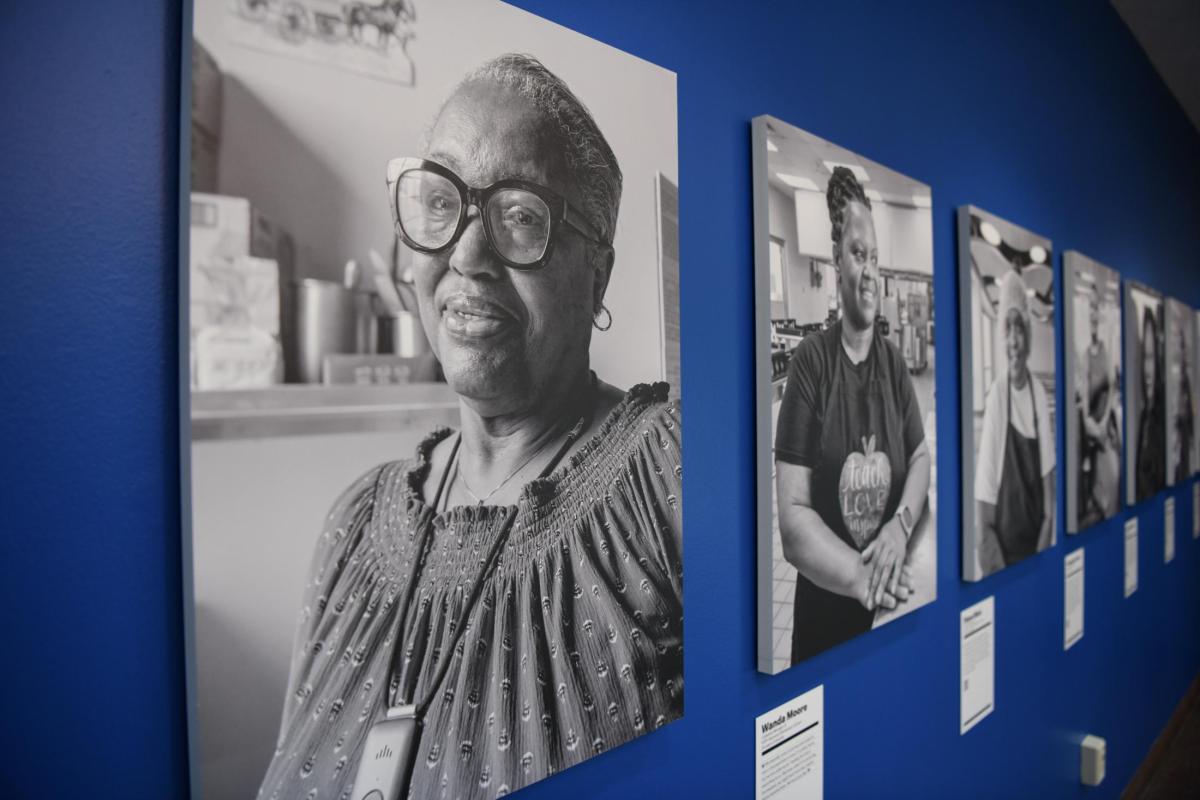
[Editor’s Note 2/9/23: The expanded Food for Thought exhibition opens at the Baltimore Museum of Industry on Friday, February 10, and will remain on view throughout the rest of the year. The smaller satellite exhibition, which has been mounted in the lobby of the City Schools headquarters since September, remains free and open to the public during regular business hours.]
Despite virtual schooling throughout the COVID-19 pandemic, food and nutrition workers in Baltimore City Public Schools continued serving around 88,000 meals per day. Now, the local unsung heroes are being recognized for that work—in addition to the work they’ve done for decades to bolster school nutrition—in a new art exhibit titled Food for Thought.
The Baltimore Museum of Industry (BMI) partnered with the school system to celebrate the district’s 573 food and nutrition service workers with the installation, which is on view in the lobby of the Baltimore City Schools headquarters at 200 E. North Avenue (free and open to the pubic during normal business hours) through June 2023.
There, spectators can browse nine worker portraits by local photojournalist—and Baltimore School for the Arts teacher—J.M. Giordano, as well as audio clips recorded by WYPR radio producer Aaron Henkin. This preview exhibition—which can also be explored online—precedes a larger display set to open at the BMI in January 2023, which is set to provide more context about food insecurity in Baltimore, as well as additional information on how the school system addresses the issue.
“This is a very moving tribute to our staff,” says Anne Rosenthal, food and nutrition specialist with Baltimore City Schools. “The portraits and words make their stories come to life. These workers are generally in the background and deserve more acknowledgement…It’s cool to bring these stories to the forefront and honor them in a meaningful way.”
When city schools had to shut down due to COVID-19 in March 2020, there was still a need for weekday meals. To ensure students were fed, food and nutrition service employees opened 28 emergency grab-and-go sites with pre-packaged meals and fresh produce. They also offered home delivery for medically fragile and high-needs students. That year, staff prepared and distributed more than 11 million meals.
“We’re delighted to be able to shine a spotlight on the workers who cared for Baltimore’s students and their families throughout the pandemic by tirelessly packaging and distributing meals to their communities,” says Beth Maloney, director of interpretation at the BMI and a member of the curatorial team for Food for Thought. “In some instances, these were the only meals families received, as many households depend on schools to provide regular meals to their children.”
According to the Centers for Disease Control, schools are essential to meeting the nutritional needs of children. In fact, many students consume up to half their daily calories at school. In Baltimore City Schools, meals have been free to all students since 2015. A report published that same year by researchers at the Johns Hopkins Center for a Livable Future, in collaboration with the Baltimore Food Policy Initiative, found that nearly 30 percent of school age children live in a food desert with limited access to healthy options. (A food desert in Baltimore City is defined as an area where residents must travel more than one-quarter of a mile to reach a supermarket; the median household income is at or below 185 percent of the federal poverty level; over 30 percent of households lack access to a vehicle; and the supply of healthy food is low.)
“It’s important to acknowledge the hard work being done behind the scenes,” Maloney says, “and to educate the public about the immediate threat of food insecurity in the country.”
The BMI, of course, focuses on the experiences of working people in Baltimore, so when staff from the school system reached out with the idea to honor the meaningful contributions of food and nutrition service workers during the height of the pandemic, the museum committed to working with them immediately. Several focus group sessions were held, in which workers who were interested in participating could ask questions and share their ideas.
“They see themselves as part of the learning environment, because students can’t learn if they are hungry,” Maloney says. “Many have been with their departments for over 30 years.”
Wanda Moore, one employee featured in the exhibit, has been a food and nutrition service worker for nearly 25 years, preparing food at several schools throughout her career, including Glenmount Elementary/Middle, KIPP Harmony Elementary, and Leith Walk Elementary/Middle. She says seeing the exhibit for the first time “really warmed her heart.”
“It brings a smile to my face,” she says. “It’s a great pleasure to see your hard work hanging on a wall.”
Rosenthal, the food and nutrition specialist with the school system, says staff members were excited to tell their stories.
“They were partners in the creative process and helped determine how the final project would culminate,” she says. “The pandemic really shed a light on how schools serve as safety nets for students by helping to meet their basic needs. Staff didn’t really get a break. The employees adjusted how and when they served and worked as frontline heroes.”
Rosenthal adds that an overarching goal behind the exhibit is for it to help remove the negative stigma around school meals. “There is a misunderstanding about what is served in our cafeterias,” she says, adding the meals are tightly regulated by federal nutrition standards and, on average, are healthier than the food available to a child at home.
Gail Pendelton, another employee who was photographed, has been working in food and nutrition for nearly 35 years: “My favorite thing about the job is knowing I helped provide kids with nutritious meals,” she says. “They ask questions about the food, too, which contributes to their learning experience.”
In her portrait, Pendelton is holding a mask in her hand—a tangible sign of the times.
“If my great, great grandchildren ever come across the project, they will know I helped children during a pandemic,” she says. “I love the kids so much…They are the most important thing, no matter what is happening.”
